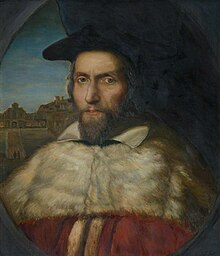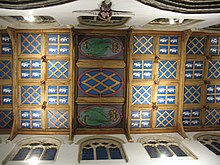Wikipedia
This text was copied from Wikipedia on 11 January 2025 at 5:10AM.
John Cosin | |
|---|---|
| Bishop of Durham | |
 | |
| Diocese | Diocese of Durham |
| In office | 1660–1672 |
| Predecessor | Thomas Morton (before the Interregnum) |
| Successor | Nathaniel Crew |
| Other post(s) | Archdeacon of the East Riding (1625–1660) Master of Peterhouse (1635–1643, 1660) Vice-Chancellor of Cambridge University (1639–1640) Dean of Peterborough (November 1640–1660) Master of Peterhouse (1660) |
| Orders | |
| Consecration | 2 December 1660 by Accepted Frewen |
| Personal details | |
| Born | (1594-11-30)30 November 1594 Norwich, Norfolk, England |
| Died | 15 January 1672(1672-01-15) (aged 77) Westminster, Middlesex, England |
| Buried | 29 April 1672, Auckland Castle chapel |
| Nationality | English |
| Denomination | Anglican |
| Parents | Giles Cosin |
| Spouse | Frances (m. 1626–1642) |
| Children | 3 sons & 2 daughters |
| Profession | theologian, writer |
| Education | Norwich Grammar School |
| Alma mater | Gonville and Caius College, Cambridge |



John Cosin (30 November 1594 – 15 January 1672) was an English bishop.
Life
He was born at Norwich, and was educated at Norwich School and at Caius College, Cambridge, where he was scholar and afterwards fellow.[1] On taking orders he was appointed secretary to John Overall, Bishop of Lichfield, and then domestic chaplain to Richard Neile, Bishop of Durham. In December 1624 he was made a prebendary of Durham, and on 9 September 1625[2] Archdeacon of the East Riding of Yorkshire (until 1660).
In 1630 he received his degree of Doctor of Divinity (DD). He first became known as an author in 1627, when he published his Collection of Private Devotions, a manual stated to have been prepared by command of King Charles I, for the use of Queen Henrietta Maria's maids of honour. This book, together with his insistence on points of ritual in his cathedral church and his friendship with William Laud, exposed Cosin to the hostility of the Puritans; and the book was criticised by William Prynne and Henry Burton. In 1628 Cosin took part in the prosecution of a brother prebendary, Peter Smart, for a sermon against high church practices; and the prebendary was deprived.
On 8 February 1635 Cosin was appointed master of Peterhouse, Cambridge; and in 1640 he became vice-chancellor of the university. In October of this year he was promoted to the deanery of Peterborough. A few days before his installation the Long Parliament had met; and among the complainants who hastened to appeal to it for redress was the ex-prebendary, Smart. His petition against the new dean was considered; and early in 1641 Cosin was sequestered from his benefices. Articles of impeachment were presented against him two months later, but he was dismissed on bail. For sending the university plate to the king, he was deprived of the mastership of Peterhouse (13 March 1643).[3][4] He went to France, preached at Paris, and served as chaplain to some members of the household of the exiled royal family. At the Restoration he returned to England, was reinstated in the mastership (3 August 1660),[4] restored to all his benefices, and in a few months raised to the see of Durham – he therefore resigned from the Mastership of Peterhouse on 18 October 1660.[4]
Cosin noted that Auckland Castle in the town of Bishop Auckland was empty and that its chapel was in ruin; he went on to improve the property, renovating the Great Hall and converting it into a new chapel that still stands today.[5][6][7]
He was elected to that See on 5 November, which election was confirmed on 22 November;[8] he was duly consecrated a bishop on 2 December[9] and enthroned on 8 December 1660.[8]
Cosin was responsible for a style of church woodwork unique to County Durham, a sumptuous fusion of gothic and contemporary Jacobean forms. The font cover in Durham Cathedral is a splendid example of this, as are the displays in the churches at Sedgefield and elsewhere. The Cosin woodwork at Brancepeth has sadly been destroyed by fire.
At the convocation in 1661 Cosin played a prominent part in the revision of the Book of Common Prayer, and endeavoured with some success to bring both prayers and rubrics into better agreement with ancient liturgies. Ultimately, his efforts produced the 1662 Book of Common Prayer, established as the authorized liturgical book of the Church of England by the Act of Uniformity 1662. He administered his diocese successfully for eleven years; and used a large share of his revenues to promote the interests of the Church, of schools and of charitable institutions.
He died in London in 1672. He had married Frances (d. 25 March 1642), the daughter of Marmaduke Blakiston[10] on 15 August 1626 at St Margaret's, Durham.[9]
Attitudes
Though a classical high churchman and a rigorous enforcer of outward conformity, Cosin was uncompromisingly hostile to Roman Catholicism, and most of his writings illustrate this antagonism. In France he was on friendly terms with Huguenots, justifying himself on the ground that their non-episcopal ordination had not been of their own seeking, and at the Savoy conference in 1661 he tried hard to effect a reconciliation with the Presbyterians. He differed from the majority of his colleagues in his strict attitude towards Sunday observance and in favouring, in the case of adultery, both divorce and the remarriage of the innocent party.
On a theological point of view, Cosin is considered to be an Arminian anti-Calvinist.[11] In particular, his book of devotions is considered by historians as Arminian and imbued with sacramentalism.[12]
Writings
Among his writings (most of which were published posthumously) are a Historia Transubstantiationis Papalis (1675), Notes and Collections on the Book of Common Prayer (1710) and A Scholastical History of the Canon of Holy Scripture (1657). A collected edition of his works, forming 5 vols of the Oxford Library of Anglo-Catholic Theology, was published between 1843 and 1855; and his Correspondence (2 vols) was edited by George Ornsby for the Surtees Society (1868–1870).
Among his notable work was the translation of "Veni Creator Spiritus" included in the 1662 revision of the Book of Common Prayer; written for the Coronation of King Charles I of Great Britain, and sung at every coronation since that time.
1. Come, Holy Ghost, our souls inspire
and lighten with celestial fire;
thou the anointing Spirit art,
who dost thy seven-fold gifts impart.
2. Thy blessed unction from above
is comfort, life, and fire of love;
enable with perpetual light
the dullness of our mortal sight.
3. Teach us to know the Father, Son,
and thee, of both, to be but one,
that through the ages all along
this may be our endless song:
4. Praise to thine eternal merit,
Father, Son, and Holy Spirit.
Amen.
Library

In 1669 Cosin founded one of the earliest public libraries to give local people access to ‘good books.’[13] A history of the collection of Cosin's books still in the library notes that it is "one of the most important British centres for the study of older books."[14]
Notes and references
Citations
- ^ "Cosin, John (CSN610J)". A Cambridge Alumni Database. University of Cambridge.
- ^ "Cosin, John (at York)". The Clergy of the Church of England Database 1540–1835. CCEd Appointment ID 88002. Retrieved 8 September 2014.
- ^ Walker, John (1863). Robert Whittaker (ed.). The sufferings of the clergy of the Church of England during the great rebellion. London. p. 169. Retrieved 26 January 2011.
{{cite book}}: CS1 maint: location missing publisher (link) - ^ a b c Roach, J.P.C. (ed.) A History of the County of Cambridge and the Isle of Ely: Volume 3: The City and University of Cambridge. Chapter: The colleges and halls: Peterhouse; section: Masters of Peterhouse. Accessed 8 September 2014
- ^ Lightfoot, Joseph Barber (1892). Leaders in the Northern Church: Sermons Preached in the Diocese of Durham. Macmillan. pp. 140.
- ^ Fordyce, p.548
- ^ "The Bishops of Durham Through Time". The Auckland Project. Archived from the original on 28 October 2019. Retrieved 28 October 2019.
- ^ a b Horn, Joyce M.; Smith, David M.; Mussett, Patrick (2004), Fasti Ecclesiae Anglicanae 1541–1857, vol. 11, pp. 73–77
- ^ a b "Cosin, John". Oxford Dictionary of National Biography (online ed.). Oxford University Press. doi:10.1093/ref:odnb/6372. (Subscription or UK public library membership required.)
- ^ The baptismal, marriage, and burial registers of the Cathedral church of Christ and Blessed Mary the virgin at Durham, 1609–1896.
- ^ Tyacke 1990, p. 119, 123-24, 126-27, 167, 171-72, 225. The relevant sources are Cosin, Works, I, pp. 58, 66, 78-79, 96-97; II, p. 115
- ^ Cressy 2006, p. 282.
- ^ Cousin's Library Durham University.
- ^ Doyle, A.I. "John Cosins (1595-1672) as a Library Maker." The Book Collector 40 (no3) Autumn 1991: 335-357.
Sources
- Tyacke, Nicholas (1990). Anti-Calvinists: the rise of English Arminianism, c. 1590-1640. Oxford: Clarendon.
- Cressy, David (2006). England on Edge: Crisis and Revolution 1640-1642. Oxford: Oxford University.
Attribution
- This article incorporates text from a publication now in the public domain: Chisholm, Hugh, ed. (1911). "Cosin, John". Encyclopædia Britannica. Vol. 7 (11th ed.). Cambridge University Press. pp. 213–214.
External links
- Project Canterbury: The Library of Anglo-Catholic Theology
- Works by John Cosin at LibriVox (public domain audiobooks)

- Cousin's Library

2 Annotations
Second Reading
Bill • Link
John Cosin was master of Peter-house in Cambridge, and dean of Peterborough, in the reign of Charles I. in which he enjoyed several other considerable preferments. He was accused of introducing superstitious innovations in the church of Durham, of which he was then prebendary, by Peter Smart, who had been prosecuted by him for preaching against episcopacy. He held his deanry but a short time, as he was the first of the clergy who were sequestered from their dignities and benefices by the parliament. In 1643, he retired to Paris, where he was appointed chaplain to the protestant part of queen Henrietta's family. He succeeded Dr. Morton in the see of Durham; and while he sat in that see, expended large sums in public and private charities and benefactions. He died Jan. 15, 1671-2, in the 78th year of his age. His principal work, which shews him to have been a man of learning, is his "Scholastical History of the Canon of the Holy Scripture;" a book still in esteem. The first edition was published, in 1657, the second in 1672.
---A Biographical History of England. J. Granger, 1779.
San Diego Sarah • Link
An atmospheric look at Durham Cathedral (with a concert by Sting as a bonus) ... some of these songs and rounds are very old, so Pepys must have known some of them.
How did the medieval masons know how to create such perfect acoustics? I don't want to think of it being an accident repeated in so many magnificent buildings across Europe.
https://www.youtube.com/watch?v=D…
Merry Christmas, and may 2021 be kind to everyone.